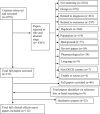The state of the art in non-pharmacological interventions for developmental stuttering. Part 1: a systematic review of effectiveness
- PMID: 26123259
- PMCID: PMC4755200
- DOI: 10.1111/1460-6984.12171
The state of the art in non-pharmacological interventions for developmental stuttering. Part 1: a systematic review of effectiveness
Abstract
Background: The growing range of available treatment options for people who stutter presents a challenge for clinicians, service managers and commissioners, who need to have access to the best available treatment evidence to guide them in providing the most appropriate interventions. While a number of reviews of interventions for specific populations or a specific type of intervention have been carried out, a broad-based systematic review across all forms of intervention for adults and children was needed to provide evidence to underpin future guidelines, inform the implementation of effective treatments and identify future research priorities.
Aims: To identify and synthesize the published research evidence on the clinical effectiveness of the broad range of non-pharmacological interventions for the management of developmental stuttering.
Methods & procedures: A systematic review of the literature reporting interventions for developmental stuttering was carried out between August 2013 and April 2014. Searches were not limited by language or location, but were restricted by date to studies published from 1990 onwards. Methods for the identification of relevant studies included electronic database searching, reference list checking, citation searching and hand searching of key journals. Appraisal of study quality was performed using a tool based on established criteria for considering risk of bias. Due to heterogeneity in intervention content and outcomes, a narrative synthesis was completed.
Main contribution: The review included all available types of intervention and found that most may be of benefit to at least some people who stutter. There was evidence, however, of considerable individual variation in response to these interventions. The review indicated that effects could be maintained following all types of interventions (although this was weakest with regard to feedback and technology interventions).
Conclusions: This review highlights a need for greater consensus with regard to the key outcomes used to evaluate stuttering interventions, and also a need for enhanced understanding of the process whereby interventions effect change. Further analysis of the variation in effectiveness for different individuals or groups is needed in order to identify who may benefit most from which intervention.
Keywords: clinical effectiveness; stammering; stuttering; systematic review.
© 2015 The Authors International Journal of Language & Communication Disorders published by John Wiley & Sons Ltd on behalf of Royal College of Speech and Language Therapists.
Similar articles
-
Non-pharmacological interventions for stuttering in children six years and younger.Cochrane Database Syst Rev. 2021 Sep 9;9(9):CD013489. doi: 10.1002/14651858.CD013489.pub2. Cochrane Database Syst Rev. 2021. PMID: 34499348 Free PMC article.
-
Non-pharmacological treatments for stuttering in children and adults: a systematic review and evaluation of clinical effectiveness, and exploration of barriers to successful outcomes.Health Technol Assess. 2016 Jan;20(2):1-302, v-vi. doi: 10.3310/hta20020. Health Technol Assess. 2016. PMID: 26767317 Free PMC article.
-
Systemic pharmacological treatments for chronic plaque psoriasis: a network meta-analysis.Cochrane Database Syst Rev. 2021 Apr 19;4(4):CD011535. doi: 10.1002/14651858.CD011535.pub4. Cochrane Database Syst Rev. 2021. Update in: Cochrane Database Syst Rev. 2022 May 23;5:CD011535. doi: 10.1002/14651858.CD011535.pub5. PMID: 33871055 Free PMC article. Updated.
-
Home treatment for mental health problems: a systematic review.Health Technol Assess. 2001;5(15):1-139. doi: 10.3310/hta5150. Health Technol Assess. 2001. PMID: 11532236
-
[Volume and health outcomes: evidence from systematic reviews and from evaluation of Italian hospital data].Epidemiol Prev. 2013 Mar-Jun;37(2-3 Suppl 2):1-100. Epidemiol Prev. 2013. PMID: 23851286 Italian.
Cited by
-
The working alliance in stuttering treatment: a neglected variable?Int J Lang Commun Disord. 2019 Jul;54(4):606-619. doi: 10.1111/1460-6984.12465. Epub 2019 Mar 13. Int J Lang Commun Disord. 2019. PMID: 30866151 Free PMC article.
-
CARE Model of Treatment for stuttering: Theory, assumptions, and preliminary findings.Front Psychol. 2024 Dec 10;15:1488328. doi: 10.3389/fpsyg.2024.1488328. eCollection 2024. Front Psychol. 2024. PMID: 39720681 Free PMC article.
-
Non-pharmacological interventions for stuttering in children six years and younger.Cochrane Database Syst Rev. 2021 Sep 9;9(9):CD013489. doi: 10.1002/14651858.CD013489.pub2. Cochrane Database Syst Rev. 2021. PMID: 34499348 Free PMC article.
-
Treatment for preschool age children who stutter: Protocol of a randomised, non-inferiority parallel group pragmatic trial with Mini-KIDS, social cognitive behaviour treatment and the Lidcombe Program-TreatPaCS.PLoS One. 2024 Jul 11;19(7):e0304212. doi: 10.1371/journal.pone.0304212. eCollection 2024. PLoS One. 2024. PMID: 38990808 Free PMC article.
-
Stuttering as a spectrum disorder: A hypothesis.Curr Res Neurobiol. 2023 Nov 1;5:100116. doi: 10.1016/j.crneur.2023.100116. eCollection 2023. Curr Res Neurobiol. 2023. PMID: 38020803 Free PMC article. Review.
References
-
- Allen, C. R. , 2011, The use of email as a component of adult stammering therapy: a preliminary report. Journal of Telemedicine and Telecare, 17, 163–167. - PubMed
-
- Amster, B. J. and Klein, E. R. , 2008, Perfectionism in people who stutter: preliminary findings using a modified cognitive–behavioral treatment approach. Behavioural and Cognitive Psychotherapy, 36, 35–40.
-
- Andrews, C. , O'BRIAN, S. , Harrison, E. , Onslow, M. , Packman, A. and Menzies, R. , 2012, Syllable‐timed speech treatment for school‐age children who stutter: a phase I trial. Language, Speech and Hearing Services in the Schools, 43, 359–369. - PubMed
-
- Andrews, G. and Cutler, J. , 1974, Stuttering therapy: the relationship between changes in symptom level and attitudes. Journal of Speech and Hearing Disorders, 38, 312–319. - PubMed
-
- Antipova, E. A. Purdy, S. C. Blakeley, M. and Williams, S. , 2008, Effects of altered auditory feedback (AAF) on stuttering frequency during monologue speech production. Journal of Fluency Disorders, 33, 74–90. - PubMed
Publication types
MeSH terms
Grants and funding
LinkOut - more resources
Full Text Sources
Other Literature Sources
Medical
Miscellaneous


